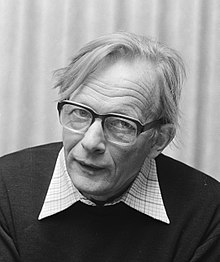Hendrik C. van de Hulst
Hendrik C. van de Hulst | |
|---|---|
 Hendrik C. van de Hulst in 1977 | |
| Born | 19 November 1918 Utrecht, the Netherlands |
| Died | 31 July 2000 (aged 81) Leiden, the Netherlands |
| Nationality | Dutch |
| Known for | 21 cm hyperfine line Anomalous diffraction theory |
| Awards | Henry Draper Medal (1955) Eddington Medal (1955) Rumford Medal (1964) Bruce Medal (1978) Karl Schwarzschild Medal (1995) |
| Scientific career | |
| Fields | Astronomy |
| Institutions | University of Leiden |
| Thesis | Optics of spherical particles (1946) |
| Doctoral advisor | Marcel Minnaert[1] |
| Doctoral students | 26,[2] including Johan Bleeker, Elly Dekker,[3] Harm Habing, Vincent Icke, Alexander Ollongren, Tim de Zeeuw |
Hendrik Christoffel "Henk" van de Hulst (19 November 1918 – 31 July 2000) was a Dutch astronomer.
In 1944, while a student in Utrecht,[4] he predicted the existence of the 21 cm hyperfine line of neutral interstellar hydrogen. After this line was discovered, he participated, with Jan Oort and Lex Muller, in the effort to use radio astronomy to map out the neutral hydrogen in our galaxy, which first revealed its spiral structure. Motivated by the scattering in cosmic dust, he studied light scattering by spherical particles and wrote his doctoral thesis on the topic,[1] subsequently formulating the anomalous diffraction theory.[5]
He spent most of his career at Leiden University, retiring in 1984. He published widely in astronomy, and dealt with the solar corona, and interstellar clouds. After 1960 he was a leader in international space research projects.[6]
In 1956 he became member of the Royal Netherlands Academy of Arts and Sciences.[7]
Books[edit]
- van de Hulst, H.C., Light Scattering by Small Particles, New York, (Wiley, 1957; Dover, 1981), ISBN 0-486-64228-3.[8]
- van de Hulst, H.C., Multiple Light Scattering, New York, Academic Press, 1980, ISBN 978-0-12-710701-1.[8]
Honors[edit]
Awards
- Henry Draper Medal of the National Academy of Sciences (1955)[9]
- Eddington Medal of the Royal Astronomical Society (1955)
- Rumford Medal of the Royal Society (1964)
- Bruce Medal of the Astronomical Society of the Pacific (1978)[10]
- Karl Schwarzschild Medal of the Astronomische Gesellschaft (1995)
Named after him
Honors[edit]
- elected to the American Philosophical Society (1960)[11]
- elected to the American Academy of Arts and Sciences (1960)[12]
- elected to the United States National Academy of Sciences (1977)[13]
See also[edit]
References[edit]
- ^ a b Habing, H. J. (February 2001). "Obituaries: Hendrik Christoffel van de Hulst, 1918-2000". Astronomy & Geophysics. 42 (1): 1.33–1.37. Bibcode:2001A&G....42a..33H. doi:10.1046/j.1468-4004.2001.0420011.33.x.
- ^ Hendrik C. van de Hulst at the Mathematics Genealogy Project . Consulted on 9 August 2023.
- ^ van der Kruit, Pieter C. (2019). "Appendix A.4: Oort and His Students: a List of Ph.D. Theses". Jan Hendrik Oort. Astrophysics and Space Science Library. Vol. 459. Springer International Publishing. pp. 633–635. doi:10.1007/978-3-030-17801-7. ISBN 978-3-030-17800-0. S2CID 199240526.
- ^ Astronomy Tree profile Hendrik Christoffel van de Hulst
- ^ van de Hulst, H. C. (1957). Light scattering by small particles. New York: John Wiley and Sons. ISBN 9780486139753.
- ^ "Hulst, Hendrik Christoffel van de." in Encyclopædia Britannica (2010)
- ^ "Hendrik Christoffel van de Hulst (1918–2000)". Royal Netherlands Academy of Arts and Sciences. Retrieved 28 July 2015.
- ^ a b "Hendrik C. van de Hulst Bibliography". Sonoma State University: Department of Physics and Astronomy. Sonoma State University. Retrieved 16 January 2020.
- ^ "Henry Draper Medal". National Academy of Sciences. Archived from the original on 26 January 2013. Retrieved 24 February 2011.
- ^ "Past Winners of the Catherine Wolfe Bruce Gold Medal". Astronomical Society of the Pacific. Archived from the original on 21 July 2011. Retrieved 24 February 2011.
- ^ "APS Member History". search.amphilsoc.org. Retrieved 1 December 2022.
- ^ "Hendrik Christoffel van de Hulst". American Academy of Arts & Sciences. Retrieved 1 December 2022.
- ^ "Hendrik C. van de Hulst". www.nasonline.org. Retrieved 1 December 2022.
Bibliography[edit]
- Tenn, Joe. "Hendrik Christoffel van de Hulst". Sonoma State University. Retrieved 5 January 2007.
- 1918 births
- 2000 deaths
- 20th-century Dutch astronomers
- Utrecht University alumni
- Academic staff of Leiden University
- Scientists from Utrecht (city)
- Foreign Members of the Royal Society
- Foreign associates of the National Academy of Sciences
- Members of the Royal Netherlands Academy of Arts and Sciences
- Dutch scientist stubs
- European astronomer stubs
- Members of the American Philosophical Society
- Optical physicists
